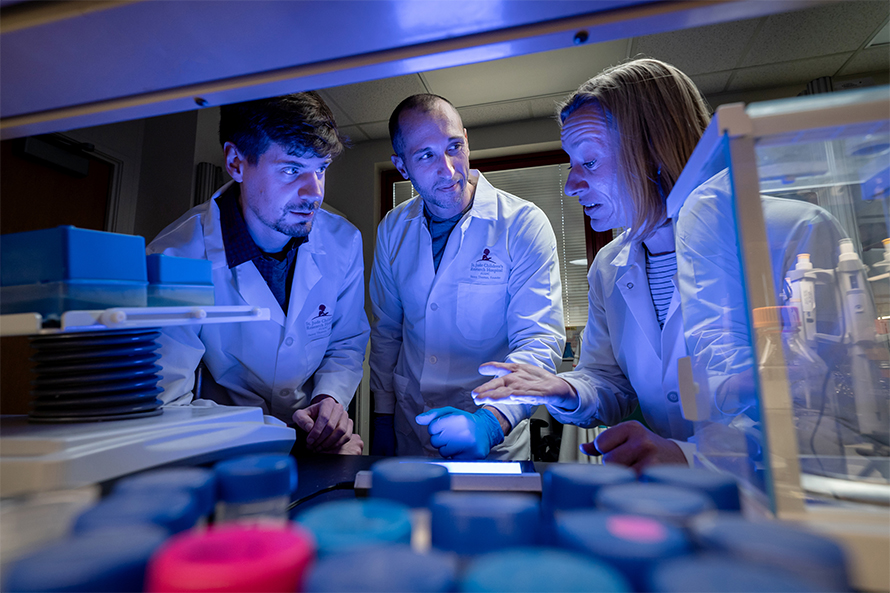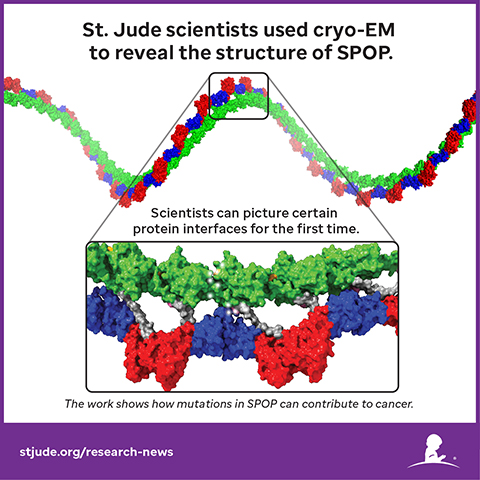Structural insights reveal how SPOP protein contributes to cancer
SPOP is the most mutated protein in prostate cancer and plays a role in endometrial, uterine and other cancers. Despite this importance, how SPOP mutations drive cancer has been incompletely understood. Scientists at St. Jude Children’s Research Hospital used cryo-electron microscopy to capture the first 3D structure of the entire SPOP assembly. The study, published in the journal Molecular Cell, revealed previously unknown SPOP interfaces that harbor clusters of cancer-causing mutations.
The normal function of SPOP is to control the level of certain proteins within a cell. When SPOP is dysregulated through mutations, it can cause dramatic effects in the cell because protein levels are altered, triggering abnormal behaviors. SPOP may not be the fire that sets cancer ablaze, but if mismanaged, it can light the fuse.
“The prostate cancer-associated mutations are well understood,” said corresponding author Tanja Mittag of the St. Jude Department of Structural Biology. “They are in the substrate-binding site and prevent SPOP from recognizing its substrates. But mutations found in patients with endometrial and other cancers were puzzling. The mutated sites did not seem to be important for SPOP function, at least looking at previous structures.”

Big picture understanding
Determining the 3D structure of SPOP using cryo-EM allowed the researchers to gain insights into the underlying mechanisms that drive the function of this protein both in its normal state and when mutated in cancer. By looking at how the SPOP oligomer assembles, the researchers were able to identify key interactions between regions of the protein, which had not been seen before. These were exactly the regions that are mutated in endometrial cancer.
“Once we had the 3D structure of SPOP, we could see that the pieces of the puzzle that had been missing were inherently important for understanding how SPOP functions in cancer,” said co-first author Matthew Cuneo. “We were now able to see that what we initially thought to be regions of SPOP without functional importance are actually key to SPOP assembly and biology.”

One mutation, dramatic effects
Previous studies had demonstrated that the SPOP protein assembles into long filaments. However, scientists could tell that the full picture had yet to be uncovered, as certain mutations unexpectedly affected this filament.
For example, mutations in the MATH domain (the part of SPOP that binds substrates) affected the propensity of the protein to assemble and hang around in cells. The researchers also observed how a single mutation could dramatically affect how the protein forms filaments. Mutating the interface that locks the MATH domain in place completely changed the assembly of the proteins from a single to a double filament with intertwined MATH domains.
Discovering these additional protein interfaces in the filament using cryo-EM helped further explain how SPOP mutations contribute to cancer.
“Taking a broader view to look at the full-length protein gave us a deeper understanding of how mutations affect SPOP,” said co-first author Brian O’Flynn. “The scale of the change just from one point mutation is huge. It was unexpected to see that.”
New questions
Researchers in the field have already experimented with drugs that target the MATH domain of SPOP. Drugs could now be developed to target specifically the mutant forms of SPOP in endometrial cancer. One of the implications of this work is that one day it might be possible to differentially target SPOP based upon its functional form within the cell.
“In addition to the questions that this research answers, what’s exciting is that for scientists asking about SPOP, the possibilities have really opened up,” O’Flynn added.
This article was first published by St. Jude Children's Research Hospital. Read the original.
Enjoy reading ASBMB Today?
Become a member to receive the print edition four times a year and the digital edition monthly.
Learn moreGet the latest from ASBMB Today
Enter your email address, and we’ll send you a weekly email with recent articles, interviews and more.
Latest in Science
Science highlights or most popular articles

Mining microbes for rare earth solutions
Joseph Cotruvo, Jr., will receive the ASBMB Mildred Cohn Young Investigator Award at the ASBMB Annual Meeting, March 7–10, just outside of Washington, D.C.

Fueling healthier aging, connecting metabolism stress and time
Biochemist Melanie McReynolds investigates how metabolism and stress shape the aging process. Her research on NAD+, a molecule central to cellular energy, reveals how maintaining its balance could promote healthier, longer lives.

Mapping proteins, one side chain at a time
Roland Dunbrack Jr. will receive the ASBMB DeLano Award for Computational Biosciences at the ASBMB Annual Meeting, March 7–10, just outside of Washington, D.C.

Exploring the link between lipids and longevity
Meng Wang will present her work on metabolism and aging at the ASBMB Annual Meeting, March 7-10, just outside of Washington, D.C.

Defining a ‘crucial gatekeeper’ of lipid metabolism
George Carman receives the Herbert Tabor Research Award at the ASBMB Annual Meeting, March 7–10, just outside of Washington, D.C.

The science of staying strong
Muscles power every movement, but they also tell the story of aging itself. Scientists are uncovering how strength fades, why some species resist it and what lifestyle and molecular clues could help preserve muscle health for life.

